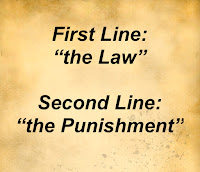3. Repeated Alternate Parallelism: in this form the parallel lines alternate, creating a 1-2, 1-2, 1-2 pattern. The following verse, features a number of prophecies concerning the crucifixion and burial of Jesus Christ: “(1) the God of Jacob, yieldeth himself, (2) according to the words of the angel,” and “(1) as a man, into the hands of wicked men, to be lifted up, (2) according to the words of Zenock,” and “(1) and to be crucified, (2) according to the words of Neum, “(1) and to be buried in a sepulcher, (2) according to the words of Zenos” (1 Nephi 19:10).
Another Example sets forth the violations of the law, with the first line (1) setting forth the violations of the law—murder, robbery, thievery, adultery, and the second line (2) follows with references to punishment: “(1) But if he murdered, (2) he was punished unto death; (1) and if he robbed (2) he was also punished; (1) and if he stole (2) he was also punished; (1) and if he committed adultery, (2) he was also punished; (1) yea, for all this wickedness, (2) they were punished” (Alma 3:10).
• Cognates: these are related words that come from the same root, for example, the English noun student is cognate to the verb study and the adjective studious. This is seen in the Book of Mormon in “Behold I have dreamed a dream” (1 Nephi 3:2). In the Hebrew language often give a verb a cognate direct object for emphasis. On the other hand, the King James Bible sometimes avoids using cognates, as in Genesis 1:11, a literal translation of the Hebrew would be "Let the earth grass grass," but the English translation reads "Let the earth bring forth grass." Cognates are often considered an awkward or inelegant style in English, but not in Hebrew. As an example, "wrote upon it a writing" (Exodus 39:30) and "she vowed a vow" (1 Samuel 1:11). Someone writing in English would be more likely to use "she vowed" or "she made a vow." Even in translation from the Hebrew, such is often found.
Thus, the Book of Mormon uses cognates much more often than we would expect if the book had originally been written in English. For example: "yoketh them with a yoke" (1 Nephi 13:5) instead of the English “Yoke them together.” Or, "succor those that stand in need of your succor" (Mosiah 4:16) instead of “Help those in need”; "sing the song" (Alma 5:26) instead of simply “sing”; "this was the desire which I desired of him" (Enos 1:13), instead of “what I desired”; “fear exceedingly” (Alma 18:5), instead of “have great fear”; "I will work a great and a marvelous work" (1 Nephi 14:7) instead of “perform a great and marvelous work”; "cursed with a sore cursing " (2 Nephi 1:22; Jacob 3:3) instead of cursed sorely or sorely cursed.
• Conjunctions: In reading the Book of Mormon, it should be noted that Hebrew conjunctions much more frequently than English does. One clear example of this can be found in lists of items. In English, the conjunction and is normally used only before the last item in a list, such as wood, iron, copper, and brass. But Hebrew usually uses a conjunction before each item. The Book of Mormon contains many examples of this Hebrew-like usage, such as this one found in 2 Nephi 5:15: "in all manner of wood, and of iron, and of copper, and of brass, and of steel, and of gold, and of silver, and of precious ores."
This kind of repetition is both prominent and annoying when reading the Book of Mormon, but to the knowledgeable, it is a source of understanding that we are reading a correctly translated document from its original form, which is Hebrew, and should lend not only authenticity, but a feeling of great understanding in the work that Joseph Smith performed, providing us with a work that is not only accurate, but accurate right down to the things that would normally annoy the typical English reader.
As an example it is reported that Professor Chaim Rabin (left), President of the Hebrew Language Academy and a specialist in the history of the Hebrew language, once used a passage from the Book of Mormon in a lecture in English to illustrate this very principle, because, he explained, it was a better illustration than passages from the English Bible.
Another difference between Hebrew and English conjunctions is that in Hebrew the same conjunction can carry both the meaning “and” and also the opposite meaning “but.” Here are two well-known Bible passages in which the King James Version renders the conjunction but:
"Of every tree of the garden thou mayest freely eat: but of the tree of the knowledge of good and evil, thou shalt not eat of it" (Genesis 2:16-17).
"And as for Ishmael . . . I will make him a great nation. But my covenant will I establish with Isaac" (Genesis 17:20-21).
Evidence for Hebraism in the Book of Mormon lies in the fact that some passages use the conjunction “and” when “but” is expected. Here, for example, are two different versions of the Lord's promise to Lehi:
"Inasmuch as ye shall keep my commandments ye shall prosper in the land; but inasmuch as ye will not keep my commandments ye shall be cut off from my presence" (2 Nephi 1:20);
compare to “Blessed art thou and thy children; and they shall be blessed, inasmuch
as they shall keep my commandments they shall prosper in the land. But
remember, inasmuch as they will not keep my commandments they shall be cut off
from the presence of the Lord” (Alma 50:20)
"Inasmuch as ye shall keep my commandments ye shall prosper in the land; and inasmuch as ye will not keep my commandments ye shall be cut off from my presence" (2 Nephi 4:4).
In one of the quotations of this promise, Joseph Smith rendered the conjunction and, while in another place, he rendered it but. In other Book of Mormon passages, Joseph translated and when in English we would expect but because a contrastive meaning is clearly called for:
"And when I speak the word of God with sharpness they tremble and anger against me; and (= but) when I use no sharpness they harden their hearts against it" (Moroni 9:4).
"He commanded the multitude that they should cease to pray, and also his disciples. And (= but) he commanded them that they should not cease to pray in their hearts" (3 Nephi 20:1).
Another difference in the use of conjunctions is that in biblical Hebrew, a language with no punctuation, the conjunction also serves as a marker of parenthesis. The words we would put inside parentheses in English are preceded by the conjunction in Hebrew, and, at the conclusion, the next phrase is introduced by the conjunction. In the following biblical example, the same conjunction has been variously rendered “and,” “for,” and “that” by the King James translators to fit the requirements of the English language:
"As they that bare the ark were come unto Jordan, and the feet of the priests that bare the ark were dipped in the brim of the water, (for Jordan overfloweth all his banks all the time of harvest,) that the waters . . . stood and rose up" (Joshua 3:15-16). We see that “for” and “that,” two English renditions of the same Hebrew conjunction, served to set off what the English translators chose to mark with the parentheses.
All of this is just another set of examples of how Joseph Smith translated the ancient writings using Hebraisms that he could not have possibly known about.
(See the final post, “It’s Very Good Hebrew – Part VIII,” for more on how the Book of Mormon fails in English but excels in Hebrew.
"Inasmuch as ye shall keep my commandments ye shall prosper in the land; and inasmuch as ye will not keep my commandments ye shall be cut off from my presence" (2 Nephi 4:4).
In one of the quotations of this promise, Joseph Smith rendered the conjunction and, while in another place, he rendered it but. In other Book of Mormon passages, Joseph translated and when in English we would expect but because a contrastive meaning is clearly called for:
"And when I speak the word of God with sharpness they tremble and anger against me; and (= but) when I use no sharpness they harden their hearts against it" (Moroni 9:4).
"He commanded the multitude that they should cease to pray, and also his disciples. And (= but) he commanded them that they should not cease to pray in their hearts" (3 Nephi 20:1).
Another difference in the use of conjunctions is that in biblical Hebrew, a language with no punctuation, the conjunction also serves as a marker of parenthesis. The words we would put inside parentheses in English are preceded by the conjunction in Hebrew, and, at the conclusion, the next phrase is introduced by the conjunction. In the following biblical example, the same conjunction has been variously rendered “and,” “for,” and “that” by the King James translators to fit the requirements of the English language:
"As they that bare the ark were come unto Jordan, and the feet of the priests that bare the ark were dipped in the brim of the water, (for Jordan overfloweth all his banks all the time of harvest,) that the waters . . . stood and rose up" (Joshua 3:15-16). We see that “for” and “that,” two English renditions of the same Hebrew conjunction, served to set off what the English translators chose to mark with the parentheses.
All of this is just another set of examples of how Joseph Smith translated the ancient writings using Hebraisms that he could not have possibly known about.
(See the final post, “It’s Very Good Hebrew – Part VIII,” for more on how the Book of Mormon fails in English but excels in Hebrew.







No comments:
Post a Comment